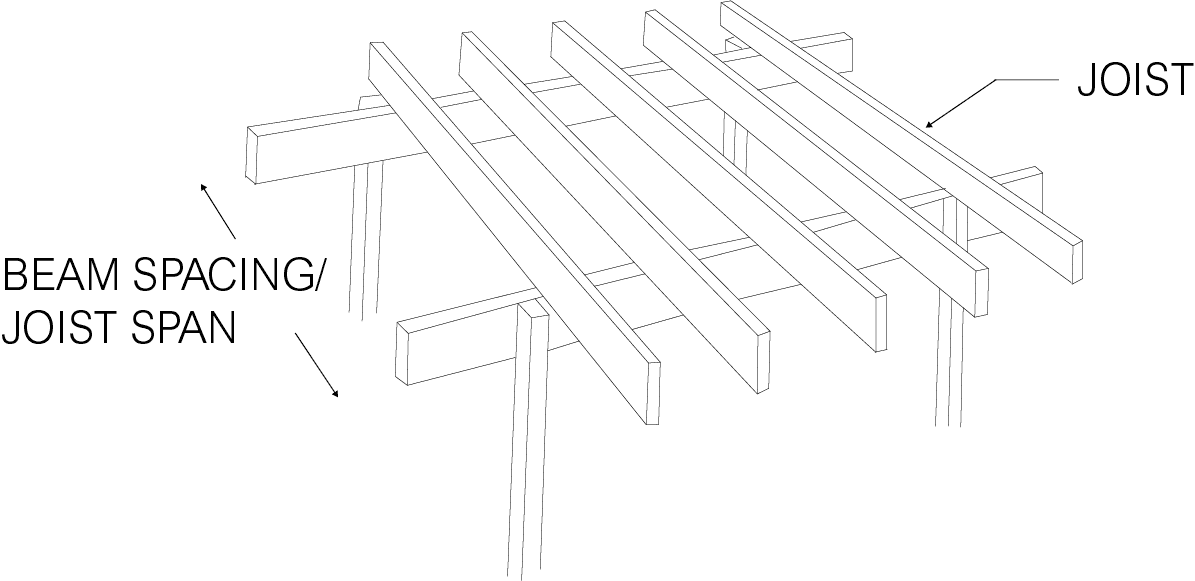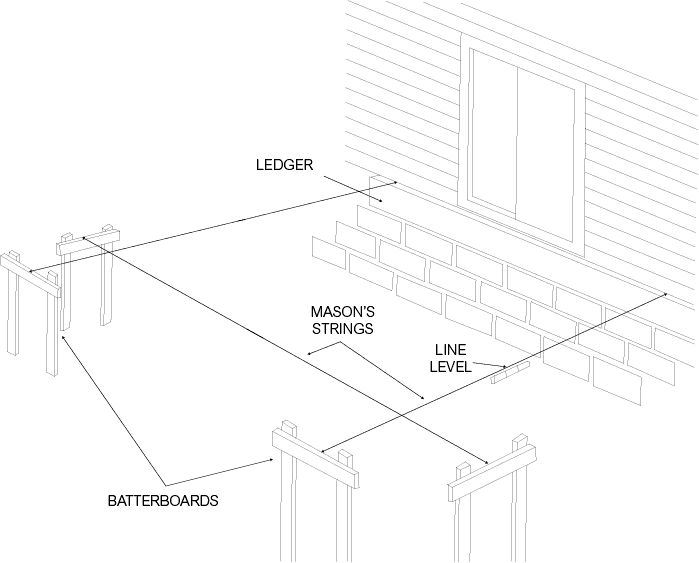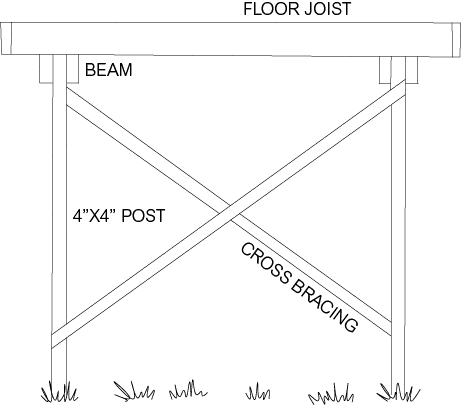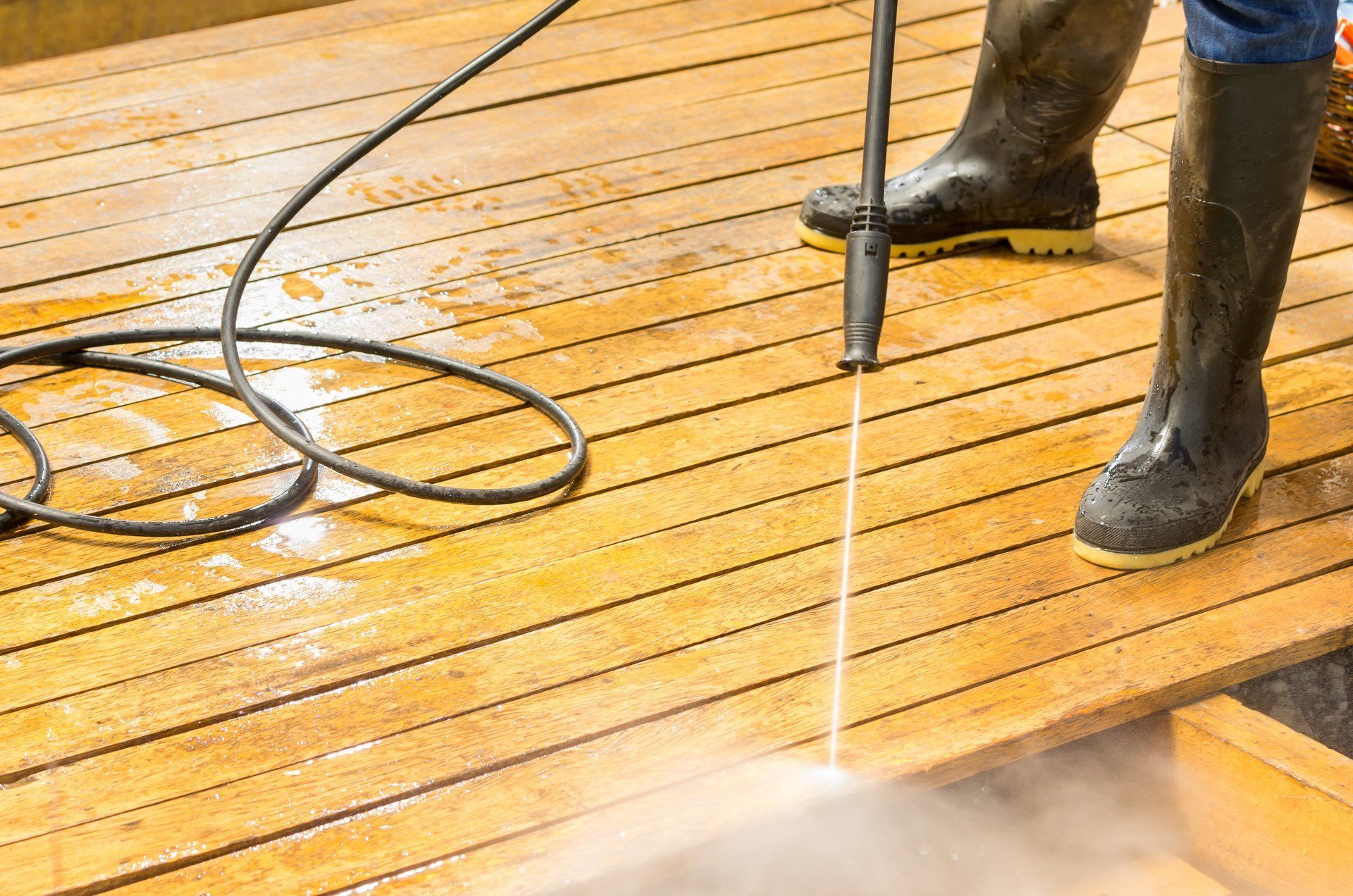Decking
Timber decking is an increasingly popular method of enhancing the aesthetic appeal of any home, garden or building. As a natural product, it is in harmony with the environment and the design is only limited to your imagination.
GETTING STARTED

Decks originally became popular as a way of adding outdoor living space on hillside lots. Today, many decks are built on level ground where they offer firm, dry footing close to the home. Decks add to the living area of your home and increase its value. Recent studies have shown that in most cases over 200% of the investment can be recouped on decks built by do-it-yourselvers when they sell their house. Decks can be built just inches from the ground or well elevated. They may be freestanding or attached to the home or other building. Before you begin construction, you need to take some basic considerations into account.
BUILDING CODE AND ZONING REQUIREMENTS
Check with your local building and planning control office to ensure that you meet all local and national planning requirements. You may wish to inform your neighbours. Many areas require building permits and your plan may need to be reviewed by your local building code office to make sure that it meets the standards set forth in local codes. Make sure you will be building within any setbacks specified in local regulations. Some communities have rigorous design guidelines and require review utilities to be sure that your proposed deck won’t interfere with access to utility lines. Finally, don’t interfere with the functioning or servicing of your septic tank if you have one.
DECK FUNCTION

How you plan to use your deck will determine the size deck you need. For family meals and entertaining, select a large deck (or combination of decks) with plenty of space for tables and benches, and consider adding built-in benches along railings to seat more people. An entry deck can be small but make it large enough for you to be able to stand and talk comfortably with guests as they arrive or leave. You should also consider what type of deck would be best suited to your home.
On-Grade Deck -
If your yard is reasonably flat, consider an on-grade deck as a beautiful, distinctive alternative to ordinary concrete or brick patios. Uncomplicated and easy to build, on-grade decks in most cases do not need posts, steps or railings. Use the framing shown below to build an on-grade deck. Then finish with deck boards.
Multi-Level Decks -
They may look, at first glance, to be complicated but multi-level decks are no more difficult to build than simple rectangular decks. In fact, a sophisticated multi-level deck can be nothing more than two rectangular decks joined together visually. Plan and build a multi-level deck with the following points in mind. Generally, multi-level decks look best when one rectangle is clearly larger than the other. Adjust the size of the rectangles to fit your own needs. The simplest way to change levels is to build the second deck 7” higher or lower than the first. If you need a greater difference, handle the change with stairs, connecting deck to deck as you would deck to ground.
YOUR CLIMATE
Sun and wind are the most important things to consider. Depending on where you live, afternoon sun can be a welcome friend or a hot, fierce enemy, so plan carefully.
Think also about which areas of your yard have pleasant, gentle breezes, or those which always seem too cold or windy. Whatever your local conditions, plan your deck to give you the sun or shade you want with protection from high winds. Every situation is unique, but the following considerations are common.
Take advantage of good views, both on and off your property and screen off unpleasant ones. Think about how your intended deck use and intended deck placement can work together. An outdoor eating-and entertaining deck should be close to or easily reached from your kitchen and living area. A deck intended for adult privacy might be better placed away from busy household activities.
Considered together all these factors may point to an excellent location for you to build your deck, but usually you will have to think about compromises and modifications. For instance, if all other things are perfect about the location of your deck, but you think you’ll want more shade, consider adding an overload arbour or a lattice screen. Is the only problem inadequate protection from high winds? Then add a taller, solid railing along one or two sides. Does an otherwise great location feel to shady or damp? Perhaps thinning some overhead tree limbs (or even removing a tree) can get more sunlight where you would like your deck.
PRESERVED TIMBER
Wood is a beautiful building material; it is attractive, natural and extremely versatile. The home and garden can be transformed with the multitude of timber products available today.
Wood can be a source of food for decay fungi and certain species of insects, so it needs protecting with a modern preservative system. All wood used needs to be treated for its intended use, i.e UC4 for ground contact. It should be capable of giving a minimum service life of 15 years, such as Celcure pressure treated timber from Koppers Performance Chemicals.
For more information on timber preservatives and user classes, please visit www.kopperspc.com
OTHER PRE-BUILD CONSIDERATIONS

• Decks in permanent shade can be affected by damp and algae growth and will need to be cleaned and
treated with a suitable preservative yearly.
• Avoid constantly wet or damp areas completely.
• A simple ground level deck should be a straight forward project. However other deck projects of a more
complicated nature will require professional help in the design and building to ensure that the
completed structure will be sound and fit for the intended use and comply with planning and building
regulations.
• Raised decks should not be built with the deck level more than 600mm above ground level without
specialist advice.
• When installing posts or levelling the ground, take special care not to damage underground cabling,
pipes or drainage, and do not permanently obstruct manhole covers or other services.
SKETCH A DECK LAYOUT
It is important to plan your deck carefully, considering the size, the light and the layout. We recommend sketching out your intended decking layout. Always start by drawing a simple plan of the house and garden. Outline where you want to position your deck. Ensure that your deck does not block access to utility services which may be required later such as drain covers etc.
Consider all the materials that are required. Timber elements include; deck bearers (ground level), stress graded joists (raised deck), decking boards, post and railing system (off ground). Make sure all materials are from sustainable and legal sources.
TOOLS REQUIRED
• A drill with drill bits
• Hammer
• Tape measure
• Spirit level
• Line level
• Combination level
• Spade
• Chalk line
• String
• Spanner
• Socket set
• Spare timber
• Batter boards
Larger projects may require professional tools which can be either hired or purchased.
• Circular saw
• Mitre saw
• Jigsaw
SAFETY
It is very important that you keep safe during construction. Please use the listed items below.
• Gloves
• Goggles
• Mask
MARK OUT THE DECK AREA
It is important to mark out the deck area with wooden pegs and builders line. This will allow you to see an accurate representation of the size of your intended deck, so you can make sure you have enough space for what you have planned.
REMOVE GRASS PLANTS
Decks usually shade the soil sufficiently to prevent most weed growth but getting weeds out of the way before you begin to build makes construction easier. After measuring and marking the deck area, remove sod from the stacked area to a depth of 4” to 6”. Replace the soil with gravel and level the surface. Make sure all weeds or grass has been cleared or a landscaping fabric is placed down as this will help prevent future growth under the deck.
COVER WITH MEMBRANE
If the ground is soggy or likely to become so in wet periods, spread pea shingle over the landscape fabric to a depth of about 25mm. Your bearer frame will bed down on the shingle and will, to a large extent, be kept off almost permanently wet ground.
Ensure the floor is level providing a 1:80 fall for drainage. If using grooved deck boards, ensure boards are laid in the direction of the fall. Subsequently the frame bearers/ joist will have to be constructed perpendicular to the direction of the groove decking and fall.
THE BUILD
Stage 1
Ledgers, posts and the outer frame
INSTALL A LEDGER

Install a ledger to anchor the deck to the house and to serve as a reference for laying out footings. The placement of the ledger determines the level of the deck floor. It is important that it is positioned at the correct height and is horizontal. If you are unsure of how to do this crucial step, consulting a professional contractor is recommended, or design your deck to be free-standing. This will eliminate the need for a ledger board. Use batter boards and mason’s strings to mark off the deck area and locate footings. The strings will help you visualise the size and appearance of the finished deck.

SQUARING WITH STRING

Attach the string to the ledger and/or batter boards making sure it is level. The batter boards should be assembled just outside of the perimeter corners of the deck. Batter boards will be used to hold and adjust strings which define the deck area and height. Use a felt tip marker to mark the string 3’ from the corner and mark 4’ from the corner in the other direction. Adjust the string until the diagonal connecting these two points is 5’. This will result in a 90-degree angle in the corner. This is commonly referred to as the 3-4-5 method.
INSTALL POSTS

Using a line level, measure in from the batter board strings the distances given in the plan for the location of the posts. The post holes should be at least 24” deep and can be up to 4’ deep. The actual depth depends on the column and the depth of the frost line in your area. Posts need to be set deeper than the frost line to avoid heaving. Check with a Solignum dealer for local requirements for depth and width of potholes. Fill the bottom of the hole with gravel and place a treated wood block on the gravel. Set the posts in the holes, check for level and brace securely. Fill the hole with concrete or alternating layers of gravel and earth. Make sure the posts are plumb and in alignment with one another. Let posts set in concrete overnight.
Setting posts in-ground is the method recommended by Solignum but there are several options available. If you have rocky soil or a deep frost line, you may want to use one of the several types of pier blocks. You do not have to dig holes when using pier blocks, and, depending on the type you choose, the posts can be attached in a variety of ways.
Post height is determined by measuring from the top of the deck to the ground plus the length of post set in the ground minus the thickness of the decking and the width of the joists. Height of posts that extend above the decking to support railings or benches is determined by adding the length of the post underground plus the distances from ground level to deck level plus the height of railing, bench or features minus width of the railing cap, seating boards or other materials. Do not cut posts to their finished length yet. Allow extra length to accommodate settling.
CONSTRUCT THE OUTER FRAME

Mark, cut and lay out the outer frame using min 80x80mm bearers. Ensure the frame rests flat and is totally supported.
As you work, treat every cut-end and drill hole with a preservative end coat to preserve the integrity of the preservative treatment.
If you find hollows under the frame or areas where it is held off the ground, adjust the ground level to prevent the deck from becoming springy.
Assemble the outer frame, clamping in place then joining the frame at each corner using two appropriate sized timber drive screws (or angle brackets and screws if preferred). As you proceed, use a spirit level to make sure the frame remains flat. Its corners should be square too, and you can check this by measuring the frames diagonals; they should be equal.
POST BRACING

Perimeter posts over 5’ high from ground to deck level need to be braced. While there are several methods of bracing, “X”-bracing is the strongest and is the method that we recommend. In X-bracing, 2x4 or 2x6 boards run diagonally from below the beams on one post to approximately one foot above ground level on the neighbouring post. If the diagonal distance is less than 8’ or greater, use 2x6s.
On corner posts, run the brace to the outside corner of the post, secure with 3/8” x 4” lag screws or 3/8 x 5-1/2” carriage bolts. Trim the end flush with the post. Braces that meet at middle posts are cut to meet at the centre line of the posts (leaving a slight gap for drainage) and attached with lag screws or carriage bolts. Where braces cross between posts, fasten them with a single 3/8” x 3-1/2” carriage bolt.
Note:
Post heights over 10’ (ground deck level) may require the services of a professional landscape architect or civil engineer. Do not exceed a 10’ post height with any of these plans without professional consultation.
ATTACH BEAMS TO POSTS

Use a string and level to find the desired deck floor height on the posts. Subtract the thickness of the deck boards and joist (use actual dimensions not nominals) to determine the correct height for securing the top of the beam to the post. Make a mark on all four sides of the post at this point. Use carriage bolts to fasten the beams flush with the mark. You can cut the posts that do not serve as railing supports before attaching the beams.
Solignum recommends using double post and beam construction, but you have the option of using 4x4 or 4x6 beams and attaching them to the posts with ready-made connectors.
ATTACH JOISTS

It is important that the surface of the deck have a rock-hard feel, especially elevated decks. To achieve this, joists should be spaced a maximum of 24” on centre. For decks over 6 feet off the ground, the maximum joist spacing should be 16” on centre. Joists are attached to the beams and ribbon joists. Blocking consists of 2x6 pieces nailed between joists to prevent buckling or twisting. Measure and cut blocking and nail through joists into ends of the block pieces. For ease of nailing, snap a chalk line across the joists where the blocking will go and stagger the pieces to the left and right of the line.
Mark, cut and fit the immediate bearers, remembering the maximum 450mm spacing limit, and checking they are flat with spirit level. Remember intermediate bearers should be perpendicular to the decking direction.
Again, treat every cut-end and drill hole with an end coat preservative. Noggins are added between joists for strength and stability.
Stage 2
deck boards
LAYING THE DECK BOARDS

Decking will be one of your deck’s most visible features, so make every effort to lay decking boards straight and in line. Butt boards together as when drying occurs, some shrinking can be expected. Also, when appearance permits, attach boards “bark side up” to help minimise cupping and warping. Attach the decking boards to each joist with a pair of 2-1/2” galvanise screws.
If you use straight planking for decking, you can trim the deck boards after they are installed to assure a straight line. Snap a chalk line flush with or up to an 1-1/2” ance, cut boards flush with the joist and add a fascia board.
DECORATION & PERSONALISATION
In addition to laying straight planking, you can choose from a variety of different patterns for attaching decking. Parquet patterns, diagonal or herringbone designs all add visual interest to the surface of your deck. These attractive patterns usually do not require more material than straight planking. More cutting and attention to precision is required.
Stage 3
Railings, stairs and accessories
RAILINGS/ BALUSTRADE

To give a deck some style you may wish to add some posts and a balustrade. Many different kits and styles now exist. If your deck is slightly raised, we suggest that you install a rail system. Dependent on the height of your deck you may have to comply with specific building regulations. Always follow the rail manufacturers advice and guidance.
Railings enhance the safety and appearance of decks. Railings must be sturdy and should be firmly attached to the framing members of the deck. They can be plain or elaborate and offer great opportunities for individual preference. Decorative ball tops and turned spindles as well as a variety of other speciality products are available to enhance railings.
Support for the railings can come from the continuation of deck posts that extend up through the deck floor or railing posts that are bolted to the outside joists or joist extensions. A common rail height is 42” but check for any special code requirements for your area. If you decide to use the deck posts, you may need to add intermittent or spacer posts for additional support. Never span more than 8 feet between railing posts. Check with your Solignum dealer for any local code restrictions.
If you choose to attach posts to the outside joists or joist extensions, you must attach each post to the rim joist with at least two 3/8”x 5” carriage bolts. For a finished look, you may want to bevel cut the end of the 4x4 post below the screwheads. Decorative handrail posts, spindles and handrail designs are available to dress up your deck. Check with your Solignum dealer for these attractive options. Once the railing posts are cut to their proper height, you can install the cap rail and other horizontal rail members. Miter cap rails where they meet at right angles over a post. Galvanized screws should be used to attach the railing cap. Benches can be integrated into the railing on one or all sides. Privacy screens can enhance the beauty of the deck and offer privacy. Screening can also be used under an elevated deck for storage or to hide an unsightly view.
STAIRS

Probably no aspect of deck construction requires more care and thought than stair building, largely because there are so many variables that can change deck to deck. The following discussion is intended to help you plan and build a safe and attractive stairway customized to your requirements. A wheelchair ramp could be an alternative to stairs.
Decide how wide stairs will be. They should be at least three feet wide, but often look and work better if they are wider. Check local codes to determine the maximum width allowed for stairs. You may need to add additional handrails on wide steps. For 2x4 or 2x6 treads laid flat, you will need 2x10 stringers at least every 42”. Middle stringers must be cut; those on either side may be cleated or cut.
For ease of construction, plan on 7” risers and approximately 11” treads, which can be made from two 2x6s or three 2x4s.
Measure total rise to determine number of steps needed. Make the first step up from the ground 4” to 10” as needed to have all other risers be 7”. Based on the number of 11” trends needed for number of risers calculated, determine where steps will meet the grade – total run. Mark this point with a stake.
Both cut and cleated stringers must be cut to fit the deck and ground. Measure the diagonal distance from the top edge of the deck to the total run stake. Purchase 2x10 stringers that are somewhat longer than this distance so that they can be trimmed to finished shape when the tread-riser relationships have been worked out.
ACCESSORISING / PERSONALISING YOUR DECK
There are many ways to give your deck a custom look including adding a bench, a wheelchair ramp, an arbor or lattice screening. Check with your Solignum dealer for more ideas on unique deck accessories.
Angling Corners -
One simple modification to square or rectangular decks is angling one or more corners. Angling the corner will require extra posts and additional beam assemblies running diagonally to the 45 degrees angle on the corner. The framing plan to the right shows where the extra posts and beam assemblies should be added. Angling all four corners will result in a hexagonal deck which is usually freestanding in the landscape.
Benches -
Benches add seating to a deck without taking up much floor space. They also help customise the deck. The bench plan below is simple to build and makes an attractive addition to a deck.
Wheelchair Ramp -
Wheelchair ramps are required in some non-residential building codes, and they are a convenient alternative to stairs especially for handicapped.
Arbor -
Add an arbor to your deck for shade and a finished look. Arbors are also attractive over concrete patios and freestanding in the landscape.
Lattice Screens -
Using pressure treated lattice around the perimeter of your deck really adds eye appeal. Lattice will cover the posts and framing and is a simple way to customise the appearance of your deck. Lattice is available in different sizes, and you may want to consider using special framing which is also available to hold the lattice in place. Check with your Solignum dealer for details.
MAINTAINING YOUR DECK

Once completed, should a deck need to be maintained, it can be coloured with an appropriate finish. If you wish to apply a finish to your preserved wood, we recommend the use of oil-based penetrating finishes that are transparent or semi-transparent. (see important information for health and safety information).
Maintaining and cleaning your decking is easy as well as being crucial. Decking should be washed at least twice a year, once in spring before the strong sun of summer and in autumn before the harsh cold of winter. Before you begin, you will need to assess the condition of your decking, this will help you see what the best products are to use.
If your decking is newly laid, leave it to weather naturally for about 6 months before staining or oiling. If choosing an oil, we would recommend using Solignum Decking Oil or Solignum Clear Water repellent which has been specially formulated to maintain and protect treated timber. Solignum Timber Decking Oil enhances and protects timber and provides water repellent. Solignum Clear Water Repellent is designed to control lateral penetrating damp (but not rising damp) by the formation of a water repellent surface on the treated material.
After you have chosen your products, you will need to clean your decking thoroughly to remove any moss, mould, algae and dirt making any paints, stains or oils easier to apply. This is done by giving your decking a good sweep, sanding any existing layers of previous paint, checking for any loose screws, scrubbing thoroughly with a scrubbing brush and washing thoroughly with clean water. Leave the decking to dry for at least 24 hours before applying an oil, paint or stain. Make sure you use the correct and suitable safety gear required when maintaining your decking.
Download PDF
Download this information in PDF format for Print purposes.
Download PDF
Our Videos
Watch our series of educational videos.
Watch Videos
Contents

